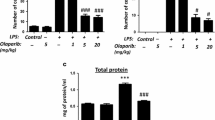Abstract.
Objective and design: Oxygen- and nitrogen-derived free radicals and oxidants play an important role in the pathogenesis of various forms of inflammation. Recent work emphasizes the importance of oxidant-induced DNA strand breakage and activation of the nuclear enzyme poly(ADP-ribose) polymerase (PARP) in the pathogenesis of various inflammatory diseases. We have recently demonstrated the efficacy of PJ34, a novel, potent phenanthridinone derivative PARP inhibitor, in rodent models of diabetic vascular dysfunction and stroke. Here we tested the efficacy of PARP inhibition in various models of local inflammation in rodents.¶Materials and methods: PJ34 (at doses of 0.03-30 mg/kg) was tested in rats and mice subjected to standard models of inflammation, with relevant parameters of inflammation measured using standard methods.¶Results: PJ34 treatment (s.c, i.p. and i.v.) dose-dependently suppressed neutrophil infiltration and nitric oxide (but not KC and IL-1β) production in peritonitis. In a model of systemic endotoxemia, PJ34 pretreatment significantly reduced plasma levels of TNF-α, IL-1β and nitrite/nitrate (breakdown products of nitric oxide) production. PJ34 treatment (oral gavage) induced a significant suppression of the inflammatory response in dextran sulfate colitis, multiple low dose streptozotocin diabetes and cyclophosphamide-accelerated autoimmune diabetes in the non-obese diabetic mice, and reduced the degree of mononuclear cell infiltration into the iris in an endotoxin-induced uveitis model. Delaying the start of PJ34 administration in the colitis model conferred significant protective effects, while in the arthritis model the post-treatment paradigm lacked protective effects.¶Conclusions: PJ34 provides significant, dose-dependent, anti-inflammatory effects in a variety of local inflammation models. Some of its actions are maintained in the post-treatment regimen and/or after discontinuation of treatment. We conclude that PARP inhibition offers a powerful means for reducing the severity of various forms of local inflammatory responses.
Similar content being viewed by others
Author information
Authors and Affiliations
Additional information
Received 20 February 2001; returned for revision 29 May 2001; accepted by E. Neugebauer 26 July 2001
Rights and permissions
About this article
Cite this article
Mabley, J., Jagtap, P., Perretti, M. et al. Anti-inflammatory effects of a novel, potent inhibitor of poly (ADP-ribose) polymerase. Inflamm. res. 50, 561–569 (2001). https://doi.org/10.1007/PL00000234
Issue Date:
DOI: https://doi.org/10.1007/PL00000234




